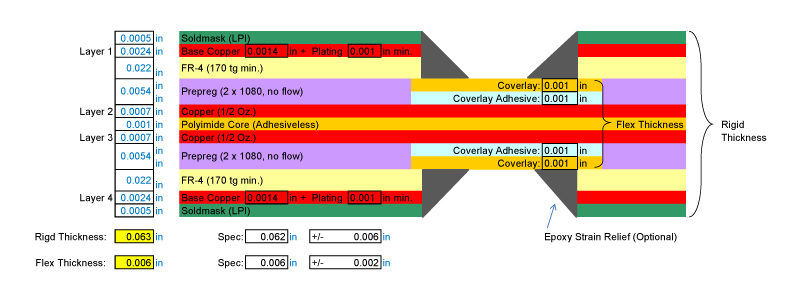Shenzhen Yingsheng Technology Co., Ltd. |
|
Verified Suppliers
|
|
Online FPC Flexible Printed Circuit Board For DVD Data Entry
What Are Flexible Circuit Boards ?
Flexible PCB Definition, For a new product to be better applied, we
need to understand exactly what it means and everything about it.
Flexible PCB, also known as flexible electronics, flexible circuit
board, Flex PCB, Flexi board, flex circuits.
YS Circuit
Flexible Circuit Boards, as the name suggests, are special types of
circuits that can bend and adjust to the shape of the device and
product in which they are installed.
They are made of a flexible substrate and have the capability to
adapt according to the shape.
Physically, you can consider flexible printed circuit (FPC) boards
just like a PCB with components, but the only difference is that
the substrate can be bent.
The same components can be mounted on an FPC, and the same
functionality can be obtained just like a normal rigid PCB.
There are special plastic substrates used to make a flexible
circuit board.
It could be Polyimide or polyester film. Sometimes, you will see a
polyester sheet and silver conductive lines on it;
We will introduce in detail later on Which material is used in
flexible PCB.
These circuits are used in special projects when you care more
about the compactness and minimalist design of the product.
It has greatly revolutionized the electronics industry and has
significantly reduced the size of products or devices.
Flexible PCB stack up
| Layer | 1-8 |
| Material | DuPont PI, Domestic Shengyi PI |
| Thickness (Finished Board) | 0.05 mm-2.0 mm |
| Max. Board Size | 406 mm*610 mm |
| Copper weight (finished) | 457mm*610mm |
| Surface Finish | Hot air solder leveling (HASL) Lead-free HASL: RoHS compliant Electroless nickel/immersion gold (ENIG): RoHS compliant Immersion Tin: RoHS compliant Organic solderability Preservatives (OSP): RoHS compliant |
| Min. Tracing/Spacing | 3 mil/3 mil |
| Min. hole size—Drilling (PTH) | 0.2mil |
| Min. hole size—Punching (NPTH) | 0.5mil |
| Tolerance of dimension | +/-0.05 mm |
| Solder-stop coating—Soldermask oil | Green, red, black, yellow, white, blue |
| Solder-stop coating—Coverlay | PI and PET film |
| Silkscreen legend color | White, black, yellow |
| Peelable solder mask | Yes |
| Gold fingers | Yes |
| Stiffener | Yes, material PI or FR4 |





FQA
1. Do you offer double-layer flexible PCB?
Yes, we make single layer flexible PCB, double sided flexible PCB,
multi-layer flexible PCB, and Rigid-Flex PCBs.
2. How many types of flexible circuit do you make?
We make different types of Flex and Rigid-Flex PCBs, depending on
the structure, base material, adhesive, appearance, insulation base
film, and metal conductor foil. Please consult our technical team
for details suitable for your application.
3. Do you provide stiffeners and cover films?
Yes, we provide black PI stiffeners, yellow PI cover films,
transparent polyimide films, white overlay, and brown PI copper
clad laminates.
4. Do you use adhesive free copper foil base material?
Yes. We have four manufacturing methods for adhesive-free copper
foil base materials. We use spray plating, curtain coating,
electroless deposition/electrolytic plating, and laminating.
5. What are the minimum and maximum thickness of your adhesive flex
PCBs?
Minimum thickness is 2 µm and the maximum is 200 µm.
We ensure high chemical durability and processing compatibility for
flexible printed circuits and do not sacrifice its original
electrical property, heat-resistant property, and mechanical
property.
6. Which IPC standards do you follow?
IPC Standards for Rigid and Flexible PCBs
The list of IPC standards below applies to rigid PCBs and flex
circuits. Take note that this list is not exhaustive, and
additional IPC standards may need to be considered.
You should consult the ipc.org website for a full list of available
IPC standards.
IPC-2221A, Generic Standard on Printed Board Design
IPC-2223, Sectional Design Standard for Flexible Printed Boards
IPC-4101, Specification for Base Materials for Rigid and Multilayer
Printed Boards
IPC-4202, Flexible Base Dielectrics for Use in Flexible Printed
Circuitry
IPC-4204, Flexible Metal-Clad Dielectrics for Use in Fabrication of
Flexible Printed CircuitryIPC-6013, Qualification and Performance
Specification for Flexible Printed Wiring
7. What is the function of the flexible circuit board?
The functions of flexible circuit boards can be divided into four
types: Lead Line, Printed Circuit, Connector, and Integration of
Function.
The use covers computers and computer peripherals—auxiliary
systems, consumer electrical appliances, automobiles, etc.
After the circuit is completed with single-sided PI copper-clad
material, it is covered with a protective film to form a flexible
circuit board with only a single-layer conductor.
By layering the flexible PCB board inside the rigid printed circuit
board material, the versatility of the flexible printed circuit is
finally combined with the stability, strength, and circuit wiring
density of the rigid printed circuit board.
This mixing opens possibilities for more complex and mechanically
challenging rigid-flex PCB designs.
Rigid-flex PCB simplifies the electronic design by eliminating
flexible cables, connectors, and discrete wiring.
Its electrical performance has been enhanced compared to its
counterparts because the circuit is an integral part of the overall
structure.
All electrical and mechanical connections are contained in the
rigid-flex PCB, providing electronic designers with greatly
improved service reliability and electrical performance.
Although the cost of rigid-flex PCBs is usually higher than
flexible PCBs and rigid PCBs.
However, rigid-flex PCBs’ reliability, weight reduction, strength,
and space-saving advantages are generally ideal in specific
applications and are superior to any other electronic packaging
technology.
Ultimately, rigid-flex PCB provides the best benefits of rigid PCBs
and flexible PCBs in one solution.
8. How you work with YScircuit?
Step 1: Submit or Send your PCB files (Gerber) and requirements to
sales@yscircuit.com, and our customer support will reply you within
2 hours.
Step 2: Place your order and our enginner will review the Gerber
and comforming you with the EQ, and then, the production will
start.
Step 3: Quality check and arrange the shipping by courier.